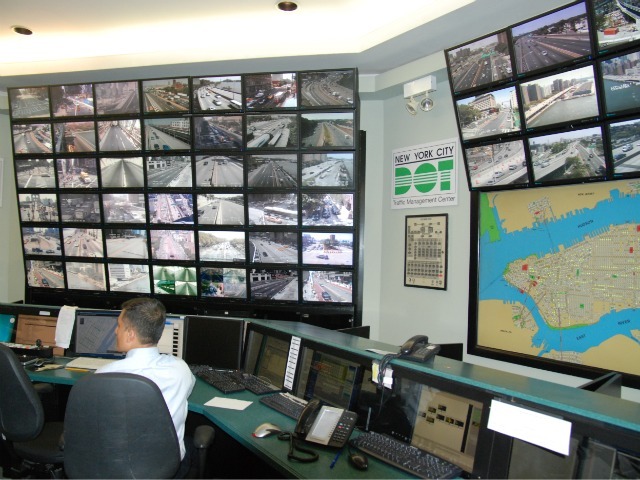
The Department of Transportation is rolling out a response to Midtown traffic congestion that is as high-tech as it is intellectually outdated. Microwave sensors, video cameras, and E-ZPass readers will gather traffic information in real-time and beam the information to the DOT's Queens command center, where engineers will instantly adjust the traffic lights as needed in an attempt to fine-tune the workings of the traffic grid.
All that technology, however, will only measure the movement of automobiles through Midtown. Moreover, new turn signals and turning lanes are being added to dozens of intersections in the affected area, between Second and Sixth Avenues and 42nd and 57th Streets. That could mean time and space taken away from other modes and given to automobiles, counter to the city's transportation goals under PlaNYC.
According to a DOT spokesperson, there is no mechanism currently in place to measure pedestrian volumes in the "Midtown in Motion" area, despite the huge number of people on Midtown sidewalks. Neither is there any transit signal priority, a system that grants a few extra seconds of green light to buses, each of which carries far more people than a few automobiles. Both of those features could theoretically be added to the system at a later date, said the DOT spokesperson.
In the meantime, however, DOT's highly capable engineers will be told to solve a problem based only on information about motor vehicles. If they wanted to balance the needs of drivers against pedestrians or bus riders in real time, much less prioritize the latter two, they wouldn't have the tools. Bus riders might benefit incidentally from a bump in overall traffic speeds, but couldn't be given the extra priority they deserve.
More permanent changes also prioritize traffic capacity over all else. At 53 intersections, turning lanes will be added to the cross-town street, replacing on-street parking, loading zones, and no standing areas. In some cases, what's being replaced might be important for pedestrian safety, whether by protecting pedestrians on the sidewalk or maintaining visibility at intersections, or needed by local businesses. Notably, the media's same hyped-up fears about any loss of parking for a bicycle or pedestrian project have not appeared when the space remains dedicated for the automobile.
Dedicated turn signals are also being added to 23 intersections. Light timing is zero-sum; a turn phase has to come from somewhere else. Though DOT's spokesperson emphasized that pedestrian times would remain within accepted minimum standards, he would not say whether adding turn signals would take away time from pedestrian crossings.
While DOT assiduously requests community board support for bike or pedestrian projects to go forward, the "Midtown in Motion" proposal seemingly went through no public review at all. That's not because these changes are uniformly uncontroversial. In February of this year, for example, Manhattan Community Board 2 unanimously passed a resolution disapproving of the addition of both turn signals and turning bays on Houston Street, believing that the changes would make conditions more hazardous for pedestrians. Officials who express the utmost concern that all transportation projects earn the support of the local community are silent.
In announcing the new traffic management system, Mayor Bloomberg brought back the transportation rhetoric of the bad old days. "Midtown is the heart of New York City’s economy, traffic is its lifeblood, and we’re about to get that blood flowing even more efficiently using communications technology,” said the mayor, according to a report in DNAinfo.
Of course, a 2006 report by the Partnership for New York City found that only a third of all people traveling to Manhattan below 60th Street came in cars, trucks, or taxis. Midtown is an unparalleled business district not because of road access or traffic management, but thanks to its unparalleled transit capacity and dense, walkable development.
Moreover, the city's Midtown traffic strategy could very well work against itself. Transportation analyst Charles Komanoff said that by his rough estimate (neither he nor Streetsblog has access to the details of the system), if "Midtown in Motion" adds the equivalent of five percent to the area's traffic capacity, it would only speed up traffic by an average of 0.75 percent across the Central Business District. That slight speed increase would draw around 1,000 additional drivers into the CBD, slowing things down again. In the end, Komanoff guessed that the plan might only increase CBD daytime speeds from their current average of 9.5 miles per hour to 9.54 mph.
That's a negligible reward for drivers who clog Midtown streets, and one that comes with no apparent benefit to those who are the true life force of Manhattan's Central Business District.





